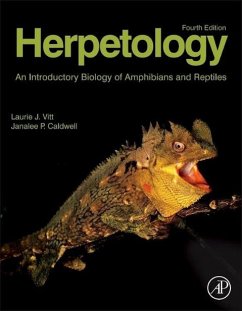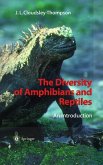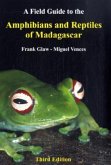The fourth edition of the textbook Herpetology covers the basic biology of amphibians and reptiles, with updates in nearly every conceptual area. Not only does it serve as a solid foundation for modern herpetology courses, but it is also relevant to courses in ecology, behavior, evolution, systematics, and morphology.
Examples taken from amphibians and reptiles throughout the world make this book a useful herpetology textbook in several countries. Naturalists, amateur herpetologists, herpetoculturists, zoo professionals, and many others will find this book readable and full of relevant natural history and distributional information.
Amphibians and reptiles have assumed a central role in research because of the diversity of ecological, physiological, morphological, behavioral, and evolutionary patterns they exhibit. This fully revised edition brings the latest research to the reader, ranging over topics in evolution, reproduction, behavior and more, allowing students and professionals to keep current with a quickly moving field.
Heavily revised and updated with discussion of squamate (lizard and snake) taxonomy and new content reflected in current literature Includes increased focus on conservation biology in herpetology while retaining solid content on organismal biology of reptiles and amphibians Presents new photos included from authors' extensive library
Hinweis: Dieser Artikel kann nur an eine deutsche Lieferadresse ausgeliefert werden.
Examples taken from amphibians and reptiles throughout the world make this book a useful herpetology textbook in several countries. Naturalists, amateur herpetologists, herpetoculturists, zoo professionals, and many others will find this book readable and full of relevant natural history and distributional information.
Amphibians and reptiles have assumed a central role in research because of the diversity of ecological, physiological, morphological, behavioral, and evolutionary patterns they exhibit. This fully revised edition brings the latest research to the reader, ranging over topics in evolution, reproduction, behavior and more, allowing students and professionals to keep current with a quickly moving field.
Heavily revised and updated with discussion of squamate (lizard and snake) taxonomy and new content reflected in current literature Includes increased focus on conservation biology in herpetology while retaining solid content on organismal biology of reptiles and amphibians Presents new photos included from authors' extensive library
Hinweis: Dieser Artikel kann nur an eine deutsche Lieferadresse ausgeliefert werden.
"In this fourth edition of their herpetology textbook, Vitt and Caldwell have broken the subject down into six main parts comprised of 22 chapters. The first three parts cover evolutionary history, reproductive schemes, and physiology. Part four covers behavioral topics such as foraging, defense strategies, and communication, while part five is devoted to ecology, conservation and geographical distribution of species. Part six breaks down the classification system used for amphibians and reptiles covering all major subgroups such as frogs, salamanders, snakes, etc." --Reference & Research Book News, December 2013
"Many of the new insights into the understanding of reptile and amphibian biology have been updated in this edition resulting in its increased size and making it a great value. This book will be an excellent addition to the library of anyone interested in herpetology." --Journal of American Veterinary Medicine Association, December 15, 2013
"Is this the best herpetology textbook available? Yes. Will I use it in my one semester course for upper-level undergraduates? Yes, this book will challenge them and would certainly also be suitable for a graduate course. Is it worth having students buy the new (4th) edition over the 3rd? Yes, updates to the content and to the references cited and enhancement of illustrations are worth it." --Phyllomedusa, December 2013
"Many of the new insights into the understanding of reptile and amphibian biology have been updated in this edition resulting in its increased size and making it a great value. This book will be an excellent addition to the library of anyone interested in herpetology." --Journal of American Veterinary Medicine Association, December 15, 2013
"Is this the best herpetology textbook available? Yes. Will I use it in my one semester course for upper-level undergraduates? Yes, this book will challenge them and would certainly also be suitable for a graduate course. Is it worth having students buy the new (4th) edition over the 3rd? Yes, updates to the content and to the references cited and enhancement of illustrations are worth it." --Phyllomedusa, December 2013








